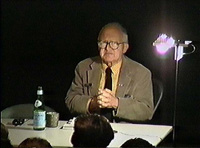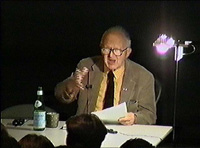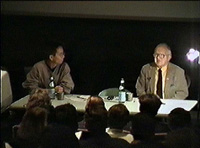for IDEA Magazine special issue on Paul Rand to be published 97.2
As a graduate student at MIT, I stumbled upon a thin, nondescript book called "Thoughts on Design" by Paul Rand. At the time I was building a reputation for myself as being a gifted graphical user interface designer. However, as I flipped through Rand's book I was humbled by the power with which he manipulated space and at the same time struck by the clarity of his accompanying prose. I was immediately inspired to pursue the field of graphic design, not necessarily pertaining to the computer.
It is ironic that 8 years later, I would return to MITas a professor of design, and that I would host a lecture by Paul Rand at MIT, which I did on November 14 of last year. The time for the lecture was set at 10am. For those familiar with how an American university works, an early lecture is very rare because students usually study late into the night and are less apt to attend events in the morning. But Rand insisted that he speak in the morning. He said, "If someone isn't willing to wake up to hear me to speak, I don't want to speak to them!"

The auditorium was packed beyond capacity with people from all over New England, some waking up as early as 5am to arrive in time for the lecture. The Director of the Media Lab, Professor Nicholas Negroponte, later remarked that during all his career at MIT he had never seen such an overwhelming audience for a morning lecture. Although conditions in the lecture hall were crowded, there was complete silence during the lecture as everyone's attention was completely focused on Rand.
The night before the lecture, we had dinner together; after which he said to me, "So, what are we going to talk about tomorrow?" My immediate reply was, "We?" He said, "Yes, it's boring if I just get up there and talk. So let's have a conversation first." So per Rand's request, I sat beside him while the lecture was given, and I began with some very basic questions. He began his lecture with the following:

PR: "I've waited 82 years to come to this place. I knew GyorgyKepes and Muriel Cooper, but they never invited me. I'm wondering why Mr. Maeda invited me at this late date, but I'll do my best".
JM: "What is design?"
"Design is the method of putting form and content together. Design, just as art, has multiple defintions, there is no single definition. Design can be art. Design can be aesthetics. Design is so simple, that's why it is so complicated."
"What is the difference between a designer and an artist?"
"There is no difference between a designer and an artist. They both work with form and content. I try to create art, whether I make it or not is not up to me, it's up to God."
"What is the difference between 'good' design and 'bad' design?"
"A bad design is irrelevant. It is superficial, pretentious, ... basically like all the stuff you see out there today."
"What are the fundamental skills of a designer?"
"The fundamental skill is talent. Talent is a rare commodity. It's all intuition. And you can't teach intuition."
"Most of your designs have lasted for several decades, what would you say is your secret?"
"Keeping it simple. Being honest, I mean, completely objective about your work. Working very hard at it."
"How did you get started as a designer?"

"I think you should ask, how did I get started as a baby?"
(raising his eyebrows)
Rand's lecture drew much laughter from the audience. He told many stories about his different logomark presentations. One that particularly stuck out was the story for the NeXT computer logomark. Rand spoke about how as Steve Jobs turned each page of the presentation booklet Jobs' smile seemed to grow bigger and bigger until finally he reached the last page and asked Rand, "Can I hug you?" and Rand replied "Sure." He then commented, "You know you've made a good logomark when your client wants to hug you."
He then relayed a separate story about work for a different client where there was a similar eager acceptance of his presentation booklet, at which time the client (a female) asked Rand, "Can I kiss you?" And Rand replied "Sure." He then commented, "You should be sure to tell your clients stories of what previous clients have done (in reference to the Jobs story). That way they try to one up the last client."
After his lecture, Rand offered to autograph copies of his books and there was a long line that did not clear up until an hour later. People would heap piles of 6 books apiece and ask for his autograph and he diligently would sign all of them. I tried to pull him away as I had to shuttle him to a private reception but he refused to leave until all the people in line were served.
His lecture was so well received at MIT, that Negroponte suggested that Rand join the faculty at the Media Laboratory, and we immediately began the process of appointing him to the faculty. Negroponte wanted me to verify Rand's interest in joining the Media Lab, afterwhich I faxed Rand explaining the situation. He replied, "Of course I accept the position" with "of course" underlined. A few days later he passed away.



